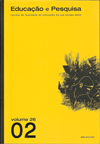Moral psychology and education: moving beyond "nice" children
DOI:
https://doi.org/10.1590/S1517-97022000000200006Keywords:
Moral development, Domain theory, Character educationAbstract
Rapid changes in society have led to calls within the United States for a return to the teaching of traditional values through programs of character education. These efforts are aimed at instilling virtues that will make children become "nice" people who are polite, respectful, and generally treat others fairly. Without objecting to the notion of raising "nice" children, questions can be raised as to whether this approach to socialization is sufficient to develop people with a critical moral perspective. Such a moral perspective is necessary to evaluate ones socially acquired values from a moral point of view. In the absence of such a capacity, one cannot avoid recapitulating the immorality imbedded within the existing set of social norms. Therefore, this article discusses recent research and theory on childrens social development that provides a basis from which to construct educational programs that go beyond preparing children to fit within the moral status quo. This developmental research indicates that conceptions of morality are distinct at all points in development from those of other non-moral social values and conventions. On the basis of that work, suggestions are provided for how to construct educational programs that recognize the complex interactions among moral and non-moral values, and that go beyond merely inculcating children within the values of society, to foster students abilities to employ their moral knowledge to evaluate social situations and guide their behavior from a critical moral standpoint.Downloads
Download data is not yet available.
Downloads
Published
2000-12-01
Issue
Section
Focus on: Ethics and Education
License
Authors assume exclusive responsibility for the concepts expressed in their articles, which do not necessarily reflect the journal’s opinion.
Permission to photocopy all or part of the material published in the journal is granted provided that the original source of publication be assigned.
How to Cite
Moral psychology and education: moving beyond "nice" children . (2000). Educação E Pesquisa, 26(2), 71-89. https://doi.org/10.1590/S1517-97022000000200006



